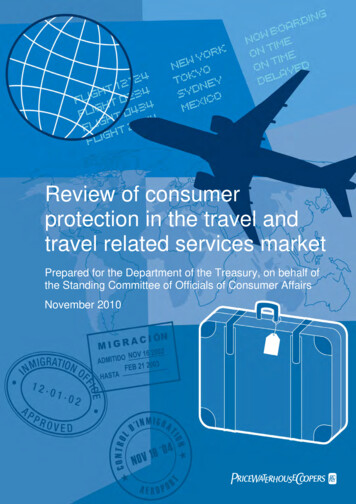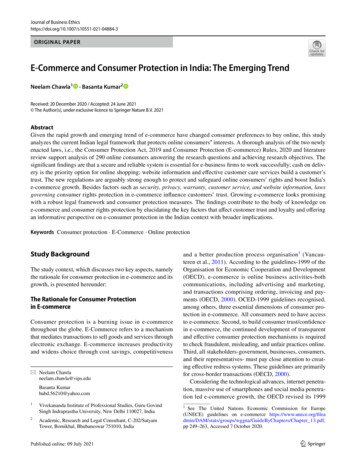
Transcription
Journal of Business IGINAL PAPERE‑Commerce and Consumer Protection in India: The Emerging TrendNeelam Chawla1· Basanta Kumar2Received: 20 December 2020 / Accepted: 24 June 2021 The Author(s), under exclusive licence to Springer Nature B.V. 2021AbstractGiven the rapid growth and emerging trend of e-commerce have changed consumer preferences to buy online, this studyanalyzes the current Indian legal framework that protects online consumers’ interests. A thorough analysis of the two newlyenacted laws, i.e., the Consumer Protection Act, 2019 and Consumer Protection (E-commerce) Rules, 2020 and literaturereview support analysis of 290 online consumers answering the research questions and achieving research objectives. Thesignificant findings are that a secure and reliable system is essential for e-business firms to work successfully; cash on delivery is the priority option for online shopping; website information and effective customer care services build a customer’strust. The new regulations are arguably strong enough to protect and safeguard online consumers’ rights and boost India’se-commerce growth. Besides factors such as security, privacy, warranty, customer service, and website information, lawsgoverning consumer rights protection in e-commerce influence customers’ trust. Growing e-commerce looks promisingwith a robust legal framework and consumer protection measures. The findings contribute to the body of knowledge one-commerce and consumer rights protection by elucidating the key factors that affect customer trust and loyalty and offeringan informative perspective on e-consumer protection in the Indian context with broader implications.Keywords Consumer protection · E-Commerce · Online protectionStudy BackgroundThe study context, which discusses two key aspects, namelythe rationale for consumer protection in e-commerce and itsgrowth, is presented hereunder:The Rationale for Consumer Protectionin E‑commerceConsumer protection is a burning issue in e-commercethroughout the globe. E-Commerce refers to a mechanismthat mediates transactions to sell goods and services throughelectronic exchange. E-commerce increases productivityand widens choice through cost savings, competitiveness* Neelam Chawlaneelam.chawla@vips.eduBasanta Kumarbabd.56210@yahoo.com1Vivekananda Institute of Professional Studies, Guru GovindSingh Indraprastha University, New Delhi 110027, India2Academic, Research and Legal Consultant, C‑202/SatyamTower, Bomikhal, Bhubaneswar 751010, Indiaand a better production process organisation1 (Vancauteren et al., 2011). According to the guidelines-1999 of theOrganisation for Economic Cooperation and Development(OECD), e-commerce is online business activities-bothcommunications, including advertising and marketing,and transactions comprising ordering, invoicing and payments (OECD, 2000). OCED-1999 guidelines recognised,among others, three essential dimensions of consumer protection in e-commerce. All consumers need to have accessto e-commerce. Second, to build consumer trust/confidencein e-commerce, the continued development of transparentand effective consumer protection mechanisms is requiredto check fraudulent, misleading, and unfair practices online.Third, all stakeholders-government, businesses, consumers,and their representatives- must pay close attention to creating effective redress systems. These guidelines are primarilyfor cross-border transactions (OECD, 2000).Considering the technological advances, internet penetration, massive use of smartphones and social media penetration led e-commerce growth, the OECD revised its 19991See The United Nations Economic Commission for Europe(UNECE) guidelines on e-commerce https:// www. unece. org/ filea dmin/ DAM/ stats/ groups/ wggna/ Guide ByCha pters/ Chapt er 13. pdf,pp 249–263, Accessed 7 October 2020.13Vol.:(0123456789)
N. Chawla, B. Kumarrecommendations for consumer protection in 2016. The2016-guidelines aim to address the growing challenges ofe-consumers’ protection by stimulating innovation and competition, including non-monetary transactions, digital content products, consumers-to-consumers (C2C) transactions,mobile devices, privacy and security risks, payment protection and product safety. Furthermore, it emphasises theimportance of consumer protection authorities in ensuringtheir ability to protect e-commerce consumers and cooperatein cross-border matters (OECD, 2016). The United NationsConference on Trade and Development (UNCTAD), in itsnotes-2017, also recognises similar consumer protectionchallenges in e-commerce. The notes look into policy measures covering relevant laws and their enforcement, consumereducation, fair business practices and international cooperation to build consumer trust (UNCTAD, 2017).E-commerce takes either the domestic (intra-border)route or cross-border (International) transactions. Invariably,six e-commerce models, i.e. Business-to-Consumer (B2C),Business-to-Business (B2B), Consumer-to-Business (C2B),Consumer-to-Consumer (C2C), Business-to-Administration(B2A) and Consumer-to-Administration (C2A) operateacross countries (UNESAP and ADB, 2019; Kumar & Chandrasekar, 2016). Irrespective of the model, the consumer isthe King in the marketplace and needs to protect his interest.However, the focus of this paper is the major e-commerceactivities covering B2B and B2C.The OECD and UNCTAD are two global consumer protection agencies that promote healthy and competitive international trade. Founded in 1960, Consumer International2(CI) is a group of around 250 consumer organisations inover 100 countries representing and defending consumerrights in international policy forums and the global marketplace. The other leading international agencies promoting healthy competition in national and international tradeare European Consumer Cooperation Network, ECC-Net(European Consumer Center Network), APEC ElectronicConsumer Directing Group (APECSG), IberoamerikanischeForum der Konsumer Protection Agenturen (FIAGC), International Consumer Protection and Enforcement Agencies(Durovic, 2020).ICPEN, in the new form, started functioning in 2002 andis now a global membership organisation of consumer protection authorities from 64 countries, including India joining in 2019 and six observing authorities (COMESA, EU,GPEN, FIAGC, OECD and UNCTAD). While it addresses2Consumer International is a champion in the sustainable consumermovement for the last 60 years. Its vision for the future of 2030 isto address three issues-sustainability, digitalization and inclusion. Seefor more details https:// www. consu mersi ntern ation al. org/ who- we- are/.13Table 1 International online fraudYearTotal reportsTotal loss (US Million)Reportedloss (%)2020 (Till 57267Source: Data compiled from https:// public. table au. com/ profi le/ feder al. trade. commi ssion# !/ vizho me/ eCons umer/ Infog raphic and https:// www. stati sta. com/ outlo ok/ 243/ 100/ ecomm erce/ world wide, Accessed17 October 2020coordination and cooperation on consumer protectionenforcement issues, disseminates information on consumerprotection trends and shares best practices on consumerprotection laws, it does not regulate financial services orproduct safety. Through econsumer.gov3 enduring initiative,ICPEN, in association with the Federal Trade Commission(FTC), redresses international online fraud.4 Econsumer.gov,a collaboration of consumer protection agencies from 41countries around the world, investigates the following typesof international online fraud: Online shopping/internet services/computer equipmentCredit and debitTelemarketing & spamJobs & making moneyImposters scam: family, friend, government, business orromanceLottery or sweepstake or prize scamsTravel & vacationsPhones/mobile devices & phone servicesSomething elseOnline criminals target personal and financial information. Online trading issues involve scammers targeting customers who buy/sell/trade online. Table 1 ononline cross-border complaints of fraud reported byeconsumer.gov reveals that international scams are rising. Total cross-border fraud during 2020 (till 30 June)was 33,968 with a reported loss of US 91.95 million asagainst 40,432 cases with a loss of US 151.3 million3econsumer.gov came into being in April 2001, addresses international scams and guides its members to combat fraud worldwide; seefor details https:// econs umer. gov/# crnt.4For more details, refer to https:// icpen. org/ consu mer- prote ction- around- world.
E‑Commerce and Consumer Protection in India: The Emerging Trend Fig. 1 Online shopping-top consumer locations and company locations. Source: Data compiled from https:// public. table au. com/ profi le/ feder al. trade. commi ssion# !/ vizho me/ eCons umer/ Infog raphic, Accessed 7 October 2020and 14,797 complaints with the loss of US 40.83 million5 years back. Among others, these complaints includedonline shopping fraud, misrepresented products, productsthat did not arrive, and refund issues. Figure 1 shows thatthe United States ranked first among the ten countrieswhere consumers lodged online fraud complaints basedon consumer and business locations. India was the thirdcountry next to France for online fraud reporting in consumer locations, while it was the fifth nation for companylocation-based reporting. Besides the USA and India,Poland, Australia, the United Kingdom, Canada, Turkey,Spain, and Mexico reported many consumer complaints.Companies in China, the United Kingdom, France, HongKong, Spain, Canada, Poland and Turkey received themost complaints. The trend is a serious global concern,with a magnitude of reported loss of above 60%.The international scenario and views on consumer protection in e-commerce provide impetus to discuss consumer protection in e-business in a regional context-India.The reason for this is that India has become a leadingcountry for online consumer fraud, putting a spotlighton electronic governance systems-which may have animpact on India’s ease of doing business ranking. However, to check fraud and ensure consumer protection ine-commerce, the government has replaced the earlierConsumer Protection Act, 1986, with the new Act-2019and E-Commerce Rule-2020 is in place now.E‑commerce GrowthE-commerce has been booming since the advent of theworldwide web (internet) in 1991, but its root is traced backto the Berlin Blockade for ordering and airlifting goods viatelex between 24 June 1948 and 12 May 1949. Since then,new technological developments, improvements in internetconnectivity, and widespread consumer and business adoption, e-commerce has helped countless companies grow.The first e-commerce transaction took place with the Boston Computer Exchange that launched its first e-commerceplatform way back in 1982 (Azamat et al., 2011; Boatenget al., 2008). E-commerce growth potential is directly associated with internet penetration (Nielsen, 2018). The increasein the worldwide use of mobile devices/smartphones hasprimarily led to the growth of e-commerce. With mobiledevices, individuals are more versatile and passive in buying and selling over the internet (Harrisson et al., 2017;Išoraitė & Miniotienė, 2018; Milan et al., (2020); Nielsen,2018; Singh, 2019; UNCTAD, 2019a, 2019b). The growthof the millennial digital-savvy workforce, mobile ubiquityand continuous optimisation of e-commerce technology ispressing the hand and speed of the historically slow-movingB2B market. The nearly US 1 Billion B2B e-commerceindustry is about to hit the perfect storm that is driving thegrowth of B2C businesses (Harrisson et al., 2017). Now,e-commerce has reshaped the global retail market (Nielsen,13
N. Chawla, B. KumarFig. 2 Global e-commerce activities and overseas online purchase. Source: Data compiled from https:// datar eport al. com/ global- dig ital-overview#: :text ercent%20per%20 year and , Accessed 12 October 20202019). The observation is that e-commerce is vibrant and anever-expanding business model; its future is even more competitive than ever, with the increasing purchasing power ofglobal buyers, the proliferation of social media users, and theincreasingly advancing infrastructure and technology (McKinsey Global Institute, 2019; UNCTAD, 2019a, 2019b).The analysis of the growth trend in e-commerce, especially since 2015, explains that online consumers continueto place a premium on both flexibility and scope of shoppingonline. With the convenience of buying and returning itemslocally, online retailers will increase their footprint (Harrisson et al., 2017). Today, e-commerce is growing acrosscountries with a compound annual growth rate (CAGR) of15% between 2014 and 2020; it is likely to grow at 25%between 2020 and 2025. Further analysis of e-commercebusiness reveals that internet penetration will be nearly60% of the population in 2020, and Smartphone penetration has reached almost 42%. Among the users, 31% are inthe age group of 25–34 years old, followed by 24% amongthe 35–44 years bracket and 22% in 18–24 years. Such avast infrastructure and networking have ensured over 70% ofthe global e-commerce activities in the Asia–Pacific region.While China alone accounts for US 740 billion, the USAaccounts for over US 560 billion (Kerick, 2019). A reviewof global shoppers making online purchases (Fig. 2) showsthat consumers look beyond their borders-cross-border purchases in all regions. While 90% of consumers visited anonline retail site by July 2020, 74% purchased a productonline, and 52% used a mobile device.The e-commerce uprising in Asia and the Pacific presentsvast economic potential. The region holds the largest shareof the B2C e-commerce market (UNCTAD, 2017). The size13of e-commerce relative to the gross domestic product was4.5% in the region by 2015. E-commerce enables small andmedium-sized enterprises to reach global markets and compete on an international scale. It has improved economic efficiency and created many new jobs in developing economiesand least developed countries, offering them a chance to narrow development gaps and increase inclusiveness—whetherdemographic, economic, geographic, cultural, or linguistic.It also helps narrow the rural–urban divide.Nevertheless, Asia’s e-commerce market remains highlyheterogeneous. In terms of e-commerce readiness—basedon the UNCTAD e-commerce index 2017, the Republic ofKorea ranks fifth globally (score 95.5) while Afghanistan,with 17 points, ranks 132 (UNCTAD, 2017). According toa joint study (2018) by the United Nations Economic andSocial Commission for Asia and the Pacific (UNESCAP)and Asian Development Bank (ADB), Asia is the fastestgrowing region in the global e-commerce marketplace.The region accounted for the largest share of the world’sbusiness-to-consumer e-commerce market (UNESCAP andADB, 2019). World Retail Congress (2019) brought outthe Global E-Commerce Market Ranking 2019 assessingthe top 30 ranking e-commerce markets on various parameters-USA, UK, China, Japan and Germany were the firsttop countries. India figured at 15 with a CAGR of 19.8%between 2018 and 2022. The report suggests that companies need to enhance every aspect of online buying, focusing on localised payment mode and duty-free return.5 The5For a detailed report, see https:// www. world retai lcong ress. com/ media/ Global ecomm erce Market Ranki ng 2019 001. pdf,Accessed 10 October 2020.
B2C Market (USD Billion)1200B2C market (US Billion)Fig. 3 Global cross-bordere-commerce (B2C) market.*Estimated to cross US 1 Trillion in 2020. Source: Authors’compilation from https:// www. inves pcro. com/ blog/ cross- border- shopp ing/, Accessed on 15October 20207158004009438481000600Shoppers (Millions 1910009008007006005004003002001000Shoppers (Million)E‑Commerce and Consumer Protection in India: The Emerging Trend 2020-July*YearFig. 4 E-Commerce growthin India during 2015–2020.Source: Data compiled fromhttps:// www. ibef. org/ news/ vision- of-a- new- india- US -5- trill ion- econo my, http:// www. ficci. in/ ficci- in- news- page. asp? nid 19630, https:// www. pwc. in/ resea rch- insig hts/ 2018/ prope lling- india- towar ds- global- leade rship- in-e- comme rce. html,https:// www. forre ster. com/ data/ forec astvi ew/ repor ts#, Accessed12 October 2020observation of this trend implies online consumers’ safetyand security.Figure 3 explains that global cross-border e-commerce(B2C) shopping is growing significantly and is estimatedto cross US 1 Trillion in 2020. Adobe Digital EconomicIndex Survey-20206 in March 2020 reported that a remarkable fact to note is about steadily accelerated growth inglobal e-commerce because of COVID-19. While virusprotection-related goods increased by 807%, toilet paperspiked by 231%. Online consumers worldwide prefer theeWallet payment system. The survey also revealed an exciting constellation that COVID-19 is further pushing overallonline inflation down.According to UNCTD’s B2C E-Commerce Index 2019survey measuring an economy’s preparedness to supportonline shopping, India ranks 73rd with 57 index values,seven times better than the 80th rank index report 2018(UNCTAD, 2019a, 2019b). The E-commerce industry hasemerged as a front-runner in the Indian economy with aninternet penetration rate of about 50% now, nearly 37% ofsmartphone internet users, launching the 4G network, internet content in the local language, and increasing consumerwealth. Massive infrastructure and policy support propelledthe e-commerce industry to reach US 64 billion in 2020,up by 39% from 2017 and will touch US 200 by 2026 witha CAGR of 21%.7 Now, India envisions a five trillion dollareconomy8 by 2024. It would be difficult with the presentgrowth rate, but not impossible, pushing for robust e-governance and a digitally empowered society. The proliferation ofsmartphones, growing internet access and booming digital76Complete report available at https:// busin ess. adobe. com/ resou rces/ digit al- econo my- index. html, Accessed 10 October 2020.https:// www. ibef. org/ news/ vision- of-a- new- india- US -5- trill ion- econo my, Accessed 7 October 2020.8Government of India’s press release, see https:// pib. gov. in/ Press Reles eDeta ilm. aspx? PRID 16039 82, Accessed 7 October 2020.13
N. Chawla, B. Kumarpayments and policy reforms are accelerating the growth ofthe e-commerce sector vis-a-vis the economy.Analysis of different studies on the growth of e-commercein India shows that while retail spending has grown by aCAGR of 22.52% during 2015–2020, online buyers haveclimbed by a CAGR of 35.44% during the same period(Fig. 4). The government’s Digital India drive beginning1 July 2015-surge using mobile wallets like Paytm, OlaMoney, Mobiwik, BHIM etc., and the declaration of demonetisation on 9 November 2016 appears to be the prime reasons for such a vast growth in the country’s e-commerceindustry. The Times of India (2020 October 12), a dailyleading Indian newspaper, reported that India’s increasein digital payments was at a CAGR of 55.1% from March2016 to March 2020, jumping from US 73,90 million to470.40, reflecting the country’s positive policy environmentand preparedness for the digital economy. The government’spolicy objective is to promote a safe, secure, sound and efficient payment system; hence, the Reserve Bank of India(RBI), the national financial and fiscal regulating authority,attempts to ensure security and increase customer trust indigital payments (RBI, 2020).The massive growth of e-commerce in countries worldwide, especially in India, has prompted an examination ofthe legal structure regulating online consumer protection.Literature Review and Research GapTheoretical FrameworkGenerally speaking, customers, as treated inferior to theircontracting partners, need protection (Daniel, 2005). Therefore, due to low bargaining power, it is agreed that theirinterests need to be secured. The ‘inequality of negotiating power’ theory emphasises the consumer’s economicallyweaker status than suppliers (Haupt, 2003; Liyang, 2019;Porter, 1979). The ‘inequality in bargaining power’ principle emphasises the customer’s economically inferior position to suppliers (Haupt, 2003). The ‘exploitation theory’also supports a similar view to the ‘weaker party’ argument.According to this theory, for two reasons, consumers needprotection: first, consumers have little choice but to buy andcontract on the terms set by increasingly large and powerfulbusinesses; second, companies can manipulate significantdiscrepancies in knowledge and complexity in their favour(Cockshott & Dieterich, 2011). However, a researcher suchas Ruhl (2011) believed that this conventional theoreticalclaim about defining the customer as the weaker party is nolonger valid in modern times. The logic was that the exploitation theory did not take into account competition betweenfirms. Through competition from other businesses, anynegotiating power that companies have vis-a-vis clients is13minimal. The study, therefore, considers that the ‘economictheory’ is the suitable theoretical rationale for consumerprotection today.The principle of ‘economic philosophy’ focuses primarilyon promoting economic productivity and preserving wealthas a benefit (Siciliani et al., 2019). As such, the contract lawhad to change a great deal to deal with modern-age consumer transactions where there is no delay between agreement and outcomes (McCoubrey & White, 1999). Thus, the‘economic theory’ justifies the flow of goods and servicesthrough electronic transactions since online markets’ versatility and rewards are greater than those of face-to-face transactions. The further argument suggests that a robust consumer protection framework can provide an impetus for thegrowth of reliability and trust in electronic commerce. The‘incentive theory’ works based on that argument to describeconsumer protection in electronic transactions (McCoubrey& White, 1999).Online shopping needs greater trust than purchasingoffline (Nielsen, 2018). From the viewpoint of ‘behaviouraleconomics, trust (faith/confidence) has long been considered a trigger for buyer–seller transactions that can providehigh standards of fulfilling trade relationships for customers(Pavlou, 2003). Pavlou (2003) supports the logical reasoning of Lee and Turban (2001) that the role of trust is offundamental importance in adequately capturing e-commerce customer behaviour. The study by O’Hara (2005)also suggests a relationship between law and trust (belief/faith), referred to as ‘safety net evaluation’, suggesting thatlaw may play a role in building trust between two parties.However, with cross-border transactions, the constraint ofestablishing adequate online trust increases, especially ifone of the parties to the transaction comes from anotherjurisdiction with a high incidence of counterfeits or a weakrule of law (Loannis et al., 2019). Thus, the law promotesthe parties’ ability to enter into a contractual obligation tothe extent that it works to reduce a contractual relationship’sinsecurity. The present research uses the idea of trust (faith/belief/confidence) as another theoretical context in line with‘behavioural economics’.As a focal point in e-commerce, trust refers to a party’sability to be vulnerable to another party’s actions; the trustor,with its involvement in networking, sees trust in the form ofrisk-taking activity (Mayer et al., 1995; Helge et al., 2020).Lack of confidence could result in weak contracts, expensivelegal protections, sales loss and business failure. Therefore,trust plays a crucial role in serving customers transcend theperceived risk of doing business online and in helping thembecome susceptible, actual or imaginary, to those inherente-business risks. While mutual benefit is usually the reasonbehind a dealing/transaction, trust is the insurance or chancethat the customer can receive that profit (Cazier, 2007). Thelevel of trust can be low or high. Low risk-taking behaviour
E‑Commerce and Consumer Protection in India: The Emerging Trend leads to lower trustor engagement, whereas high risk-takingparticipation leads to higher trustor engagement (Helgeet al., 2020). The theory of trust propounded by (Mayeret al., 1995) suggests that trust formation depends on threecomponents, viz. ability, benevolence, and integrity (ABImodel). From the analysis of the previous studies (Mayeret al., 1995; Cazier, 2007; Helge et al., 2020), the followingdimensions of the ABI model emerge:DimensionsDescriptionAbilityCompetence and characteristicsof vendors in influencing andapproving a particular area ordomain-level service to theconsumerElements: technological skillsand solutions to provide thecore service, as well as privacy,security, data protection, andpreparednessConcerns caring, and it’s the musefor client loyaltyElements: attention, empathy,belief and acceptanceCompliance with laws and transparent consistency and links toattitude and behaviour of sellersin running their businessElements: equality, satisfaction,allegiance, fairness, and reliabilityBenevolenceIntegrityPrecisely, ability, benevolence and integrity have a directinfluence on the trust of e-commerce customers.Gaining the trust of consumers and developing a relationship has become more challenging for e-businesses. The primary reasons are weak online security, lack of effectivenessof the electronic payment system, lack of effective marketing program, delay in delivery, low quality of goods andservices, and ineffective return policy (Kamari & Kamari,2012; Mangiaracina & Perego, 2009). These weaknessesadversely impact business operations profoundly later.Among the challenges that are the reasons for the distrustof customers and downsides of e-commerce is that the onlinepayment mechanism is widely insecure. The lack of trust inelectronic payment is the one that impacts negatively on thee-commerce industry, and this issue is still prevalent (Mangiaracina & Perego, 2009). The revelation of a recent study9See CUTS International survey at https:// cuts- citee. org/ pdf/ Discu ssion Paper E- Comme rce in t he Conte xt of Trade Consu mer Prote ction and Compe tition in India. pdf, CSA Research at https:// insig hts. csa- resea rch. com/ repor tacti on/ 30501 3126/ Marke ting, https:// insig hts. csa- resea rch. com/ repor tacti on/ 30501 3125/ Marke ting,andUNTAD study at https:// unctad. org/ page/ data- prote ction- and- priva cy- legis lation- world wide, Accessed 12 December 2020.(Orendorff, 2019) and survey results9 on trust-building, particularly about the method of payment, preferred languageand data protection, is fascinating. The mode of payment isanother matter of trust-building. Today’s customers wish toshop in their local currency seamlessly. In an online shoppers’ survey of 30,000 respondents in 2019, about 92% ofcustomers preferred to purchase in their local currency,and 33% abandoned a buy if pricing was listed in US only(Orendorff, 2019). Airbnb, an online accommodation booking e-business that began operations in 2009, has expandedand spread its wings globally as of September 2020-over 220countries and 100 k cities serving 7 billion customers(guests) with local currency payment options.10Common Sense Advisory Survey11-Nov. 2019-Feb. 2020with 8709 online shoppers (B2C) in 29 countries, reportedthat 75% of them preferred to purchase products if the information was in their native language. About 60% confirmedthat they rarely/never bought from an English-only websitebecause they can’t read. Similarly, its survey of 956 businesspeople (B2B) moved in a similar direction. Whether it isB2B or B2C customers, they wanted to go beyond Googletranslator-this is about language being a front-line issuemaking or breaking global sales. Leading Indian e-commerce companies like Amazon12 and Flipkart13 have startedcapturing the subsequent 100 million users by providing textand voice-based consumer support in vernacular languages.These observations suggest trust in information that the customers can rely upon for a successful transaction.Data protection is probably the most severe risk of e-commerce. The marketplaces witness so many violations thatit often seems that everyone gets hacked, which makes it areal challenge to guarantee that your store is safe and secure.For e-commerce firms, preserving the data is a considerable expense; it points a finger to maintaining the safety andsecurity of the e-commerce consumers’ data privacy in compliance with General Data Protection Regulations (GDPR)across countries.1410https:// i nnov a tion t acti c s. c om/ b usin e ss- m odel- c anvas- a irbnb/,Accessed 12 December 2020.11Detailed findings at https:// insig hts. csa- resea rch. com/ repor tacti on/ 30501 3125/ Marke ting, Accessed 19 October 2020.12Amazon India began testing a Hindi for its mobile website, marking its first foray into vernacular languages in August 2018.13Flipkart started voice assist in multiple languages-Hindi and English to make shopping easier in June 2020.14See cross-border shopping statistics and trends at https:// www. inves pcro. com/ blog/ cross- border- shopp ing/, Accessed 15 October2020.13
N. Chawla, B. KumarPwC’s Global Consumer Insight Survey 2020 reports thatwhile customers’ buying habits would become more volatile post-COVID 19, consumers’ experience requires safety,accessibility, and digital engagement would be robust anddiversified.15 The report reveals that the COVID-19 outbreakpushed the popularity of mobile shopping. Online groceryshopping (including phone use) has increased by nearly63% post-COVID than before social distancing executionand is likely to increase to 86% until its removal. Knowing the speed of market change will place companies in aposition to handle the disruption-
Online criminals target personal and financial infor-mation. Online trading issues involve scammers target-ing customers who buy/sell/trade online. Table 1 on online cross-border complaints of fraud reported by econsumer.gov reveals that international scams are ris-ing. Total cross-border fraud during 2020 (till 30 June)
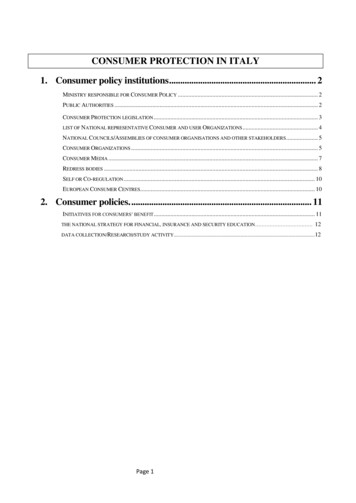
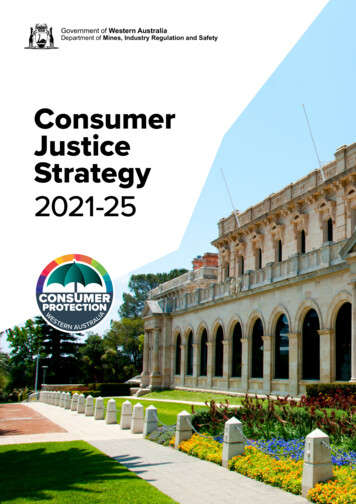



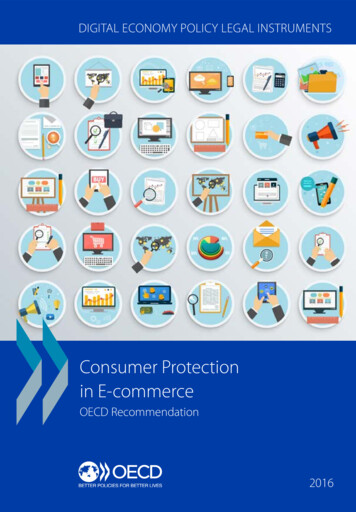
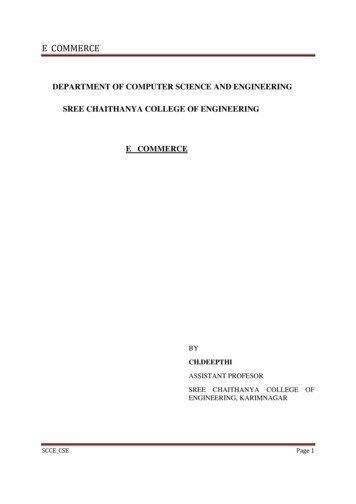
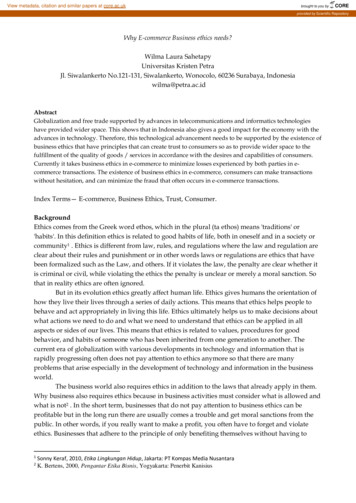
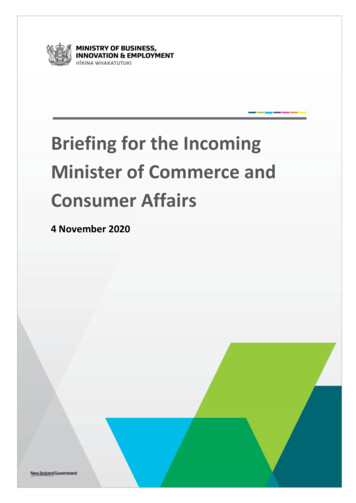
![Chapter 11. Consumer Protection. [Note] - Montgomery County, Maryland](/img/40/chap11.jpg)
